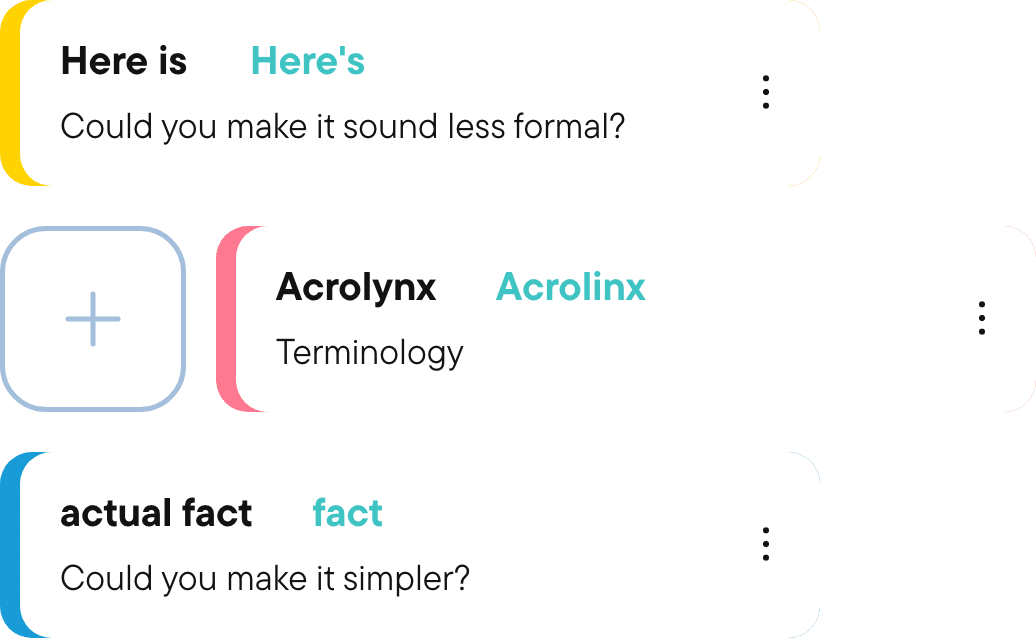Characteristics of inclusive language

Explore the hub
Where can you improve?
Inclusive language is a considered, respectful choice of words, both written and spoken, in order to create belonging and possibilities for all people to flourish. But where do you find examples of inclusive language?
There exists a few different characteristics of inclusive language. When planning an inclusive language initiative as part of your content strategy, you should consider incorporating these aspects.
- Historically conscious language
- Gender neutral language
- Plain language writing conventions
- Properly acknowledging people and cultures
- Accessible language
- Intentional language (avoids unnecessary descriptions)
- Non-stereotypical language
- Accurate representation of diverse audiences
Characteristics of inclusive language
| Type | Avoid | Use Instead | Why |
| Gender-neutral | Latino/Latina | Latinx | Avoid the stereotype that gender is binary. |
| Person-first | Homeless person | A person experiencing homelessness, a person without a home | Put people before a disability, diagnosis, or disorder because it doesn't make up their identity. |
| Proper acknowledgment of people and cultures | indigenous peoples | Indigenous Peoples | Capitalize the names of cultures, nationalities, and religions. |
| Respectful language | Sexual preference | Sexual orientation | This term has a contested implication that someone’s sexuality is their choice. |
| Accessible language | Behind the eight ball | At a disadvantage | This phrase comes from pool/billiards, which isn't familiar to everyone. |
| History-conscious language | Redline | Priority line | This term refers to the systematic denial of services to people living in certain areas based on their race or ethnicity. |
| Intentional language | A female scientist | A scientist | Think about what descriptions are necessary. In this case, mentioning someone’s gender isn’t. |
| Non-stereotypical language | Man up | Be brave | This term perpetuates stereotypes that men need to appear strong at all times and implies women can’t be. |
| Diverse and accurate representation | Manmade | Artificial, manufactured | This phrase ignores the role women and non-binary people play in shaping our history and innovating our future. |
Consider this text. Which characteristics of inclusive language could you improve to be more inclusive?
Dianne is a black African-American woman who works for a law firm. She’s a manager of a small but diverse team, consisting of Blake and Valentina. Valentina is Latina, and cares deeply about inclusive language in her team’s content, particularly because her partner is transgendered. This quarter, the team needs extra manpower to get things done, so they’re hiring an intern through an agency who gives high school dropouts work experience. As a disabled person, Blake was initially worried he’d be overlooked for such professional development opportunities, like supervising an intern. “Don’t be crazy” Dianne told him “You’ll be great!” On Thursdays, the firm gives free legal advice to illegal immigrants who are trying to navigate the system's crippling bureaucracy.
Substitute these non-inclusive words for more inclusive alternatives:
- Is it really necessary to draw attention to all Dianne’s personal characteristics? How many details are really relevant to the context? Very few.
- African-American should be written without the hyphen. The hyphen has a history of derogatory use and might imply that African Americans aren’t “real” Americans.
- Latina is a gendered word. Replace with Latinx to make it gender neutral!
- Transgendered isn’t a verb, so it doesn’t need an "-ed" ending. In the verb form, it suggests that being trans is something that happens to someone, as opposed to an identity someone is born with. The inclusive word is “transgender.”
- Manpower uses a generic masculine. Try to make it gender neutral with “staff” or “workforce” or “resources.”
- High school dropouts is deficit-based language that focuses on what people lack, rather than the talents they possess. In this case, a more specific descriptor is actually helpful, such as “people who don’t have a high school diploma.”
- Rewrite “disabled person” in person-first language, so “a person with a disability,” which puts the person before their condition. Also know that some members of the disabled community do prefer identity-first language.
- Calling someone “crazy” perpetuates mental health stigma by associating it with negative or undesirable situations. It’s also a vague word. You can be more inclusive by simply using language more precisely.
- Illegal immigrants. Although a status may be illegal, a person is not. Try replacing this term with bias-free language, such as “undocumented people” or “undocumented workers.”
- Avoid using “crippled” as an adjective. It's an ableist choice of language that’s based on the belief that typical abilities are superior.
Let’s read the text again, rewritten in a more inclusive way.
Dianne is an African American lawyer. She’s a manager of a small but diverse team, consisting of Blake and Valentina. Valentina is Latinx, and cares deeply about inclusive language in her team’s content, particularly because her partner is transgender. This quarter, the team needs extra resources to get things done, so they’re hiring an intern through an agency who gives people without college degrees work experience. As someone with a disability, Blake was initially worried he’d be overlooked for such professional development opportunities, like supervising an intern. “Don’t be worried,” Dianne told him, “You’ll be great!” On Thursdays, the firm gives free legal advice to undocumented immigrants who are trying to navigate the system’s overwhelming/oppressive/complicated bureaucracy.
Gender Neutral Language
What's Gendered Language?
Gendered language is present in approximately one quarter of the world’s languages. In English, it’s best understood as language that has a bias toward a particular sex or social gender. That would include using gendered terms referring to professions or people, or to refer to a general group of people.
For example, when we default to the generic masculine, we rob female-identifying individuals and non-binary folk of the chance to see themselves fulfilling that opportunity. It can lead to lower participation of women in technical roles, erasure of non-binary identities from the workforce, or undermine your confidence in someone’s ability to do the job based on their gender. In educational settings, gendered language is also associated with a greater gender gap in educational attainment.
Gender neutral language
The way we speak influences the possibilities we see for ourselves and who we expect to see in certain situations or job roles. Gender neutral language acknowledges that gender doesn’t have to be binary and allows the possibility for all genders to see themselves in all roles and areas of society.
Here are some examples of gender neutral language. For those who want to add gender neutral language into their enterprise content strategy, we also have a blog for more detailed guidance on gender neutral language in business writing.
| Gendered | Gender neutral |
| Mankind | Humanity |
| Congressmen | Members of Congress |
| Dear Mr. / Ms. / Mrs. / Miss | Dear Mx. |
| Husband / Wife | Spouse / Partner |
| Brother / Sister | Sibling / Family member |
| Chairman | Chairperson |
| Hostess | Host |
| Latino / Latina | Latinx |
| He / She | They / Theirs |
| Businessman | Business person |
| Ladies and Gentleman | Everyone / Folks |
| Landlord | Owner / Property Manager |
| Man a job or project | Staff a job or project |
| Actress | Actor |
Remember, it’s not just about non-binary individuals. Many women prefer not to be subsumed into a group of “ladies” because of society’s expectations and stereotypes about how women should behave.
Want more support on how to write in gender neutral language across your business content? No problem! Not only do we have an Acrolinx Inclusive Language Guide that covers all characteristics of inclusive language, but the APA Publication Manual has some great info on removing bias in your writing.
Ready for content success?
See how our AI capabilities help you create and maintain high-quality content in our demo.

